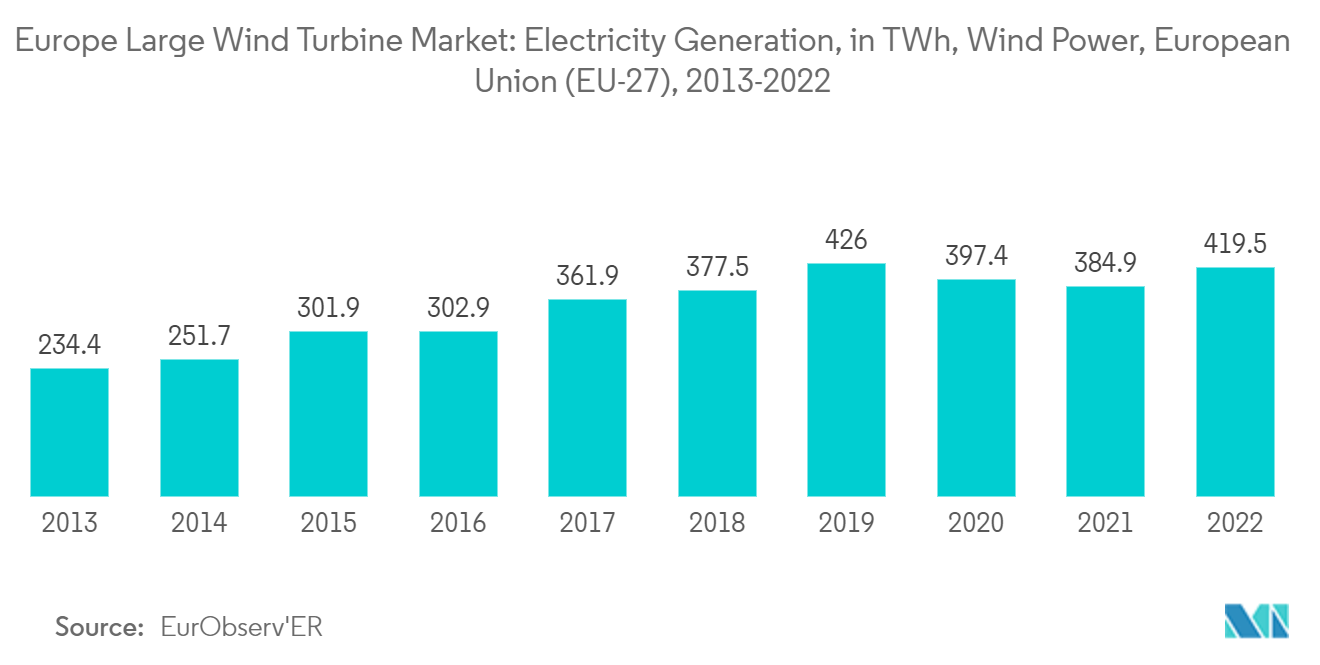Market Trends of Europe Large Wind Turbine Industry
Onshore Segment to Dominate the Market
- Onshore wind energy power generation technology has evolved over the last five years to maximize electricity produced per megawatt capacity installed and to cover more sites with lower wind speeds. Besides this, in recent years, wind turbines have become more extensive with taller hub heights, broader diameters, and larger wind turbine blades.
- In Europe, over 81% of the new wind installations were the onshore wind, with around 14.05 GW. Sweden, Germany, and Turkey are building the most onshore wind installations. In 2022, Germany was the European leader in terms of investment in new wind farms. That year, Germany invested USD 2.6 billion in new wind projects, all of which went toward onshore wind installations.
- During the past year, Sweden has seen a record number of wind installations as onshore installations have more than doubled year-over-year. Sweden now has the most onshore wind capacity in Europe, with 2.1 GW of new onshore installations.
- In July 2022, a project was announced in Sweden to build a new 277 MW wind farm starting in 2025. Three companies will be in charge of the project; Siemens Gamesa, Arise and Foresight are likely to collaborate on a new project in Sweden.
- Sweden government has planned to increase the share of renewable energy in the power mix to 40% by 2030. The government announced an increase in the expenditure on renewables, from USD 5.4 billion to USD 8.7 billion annually. This, in turn, is likely to aid the growth of the large wind turbine rotor market during the forecast period.
- Furthermore, according to WindEurope, onshore wind energy will lead the market demand in the European region to achieve net-zero carbon emissions by 2030. According to GWEC, onshore wind energy capacity takes around 90% of the total wind energy. The strict government regulations to reduce carbon emissions and phase out conventional power systems are expected to drive the market.
- Thus, such developments in the region are expected to support the large wind turbine market during the forecast period.

Germany to Dominate the Market
- Germany is rich in wind power generation. Growing wind power plants in the offshore area are becoming a lucrative market due to higher wind speed in comparison to onshore wind. Thus, offshore wind-based electricity generation is expected to witness significant growth.
- Also, the German government, coastal states, and transmission system operators (TSOs) have agreed on a joint plan to expand offshore wind development in the North and Baltic Seas and lift the country's offshore installed capacity target to 20 GW by 2030. This in turn culminates in the growth of the large wind turbine rotor market.
- According to WindEurope, as of 2021, 236 GW of wind energy capacity is installed in Europe. Germany continues to have the largest installed capacity, followed by Spain, the United Kingdom, France, and Sweden.
- At the end of the year 2022, there were a total of 28,443 onshore wind turbines in Germany. Also, 551 new onshore wind turbines with a capacity of 2.4 GW were newly installed in the year 2022. The total installed capacity of onshore wind energy is 58.106 GW.
- The amount of electricity generated from wind power in the European Union (EU) totaled 419.5 terawatt hours in 2022. This was an increase of about 8.4 percent in comparison to the previous year. Among EU member states, Germany produced the most electricity from wind power, generating nearly 125 terawatt hours that same year..
- In June 2022, the German Parliament adopted a new Onshore Wind Law, i.e., WindLandG, which aims to develop onshore wind-based power plants by a massive 10 GW a year starting from 2025. It's part of Germany's "Easter Package" of measures that enshrines the principle that the expansion of renewables is a matter of overriding public interest.
- Therefore considering the above-mentioned points, Germany is likely to dominate the market during the forecast period.


